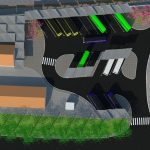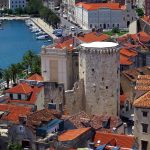The City of Split announced a 5 million kuna public tender for the contractor for a new, temporary bus and train station in Kopilica, as well as for a total of four parking and car parking areas. This is the first concrete step towards the ‘mini metro’ in the city, a train between Kopilica and the city center itself, which should be operational in June this year, reports T.portal on January 3, 2019.
As we announced earlier this week, the tender ends on January 18, and the deadline for the construction is three months. The plans entail renovating the old building owned by HŽ Cargo, constructing a bus station with 18-platforms, a car park with two hundred spaces and a large parking area for tourist buses.
From this location, passengers will travel through the existing railway tunnel on trains running every ten minutes – and the ride will only take a few minutes into the center. This is a temporary solution to circumvent the miserable crowds that rule in Split in the summer months.
Kopilica has long been designated in Split’s plans as the next major traffic junction with a large railway and bus station, which was proclaimed a state-of-the-art project at a recent session of the Government in Split. However, it is anticipated that it will take several years for its implementation and that this would be a temporary solution.
“After the government session, we are intensively working on studies and projects for the final solution, but in parallel, we have to act to ‘survive’ the summer and enable the healthy coexistence of our citizens and tourists. Traffic that does not necessarily need to go towards the center of the city will be diverted to Kopilica, and we will also introduce stimulating measures to make this happen,” the deputy mayor of Split Nino Vela said.
According to Vela, a new measure will be introduced following the model of Dubrovnik: the fees for tourist buses entering the center of Split will double, to 700 or 800 kuna, while an hour of parking at Kopilica will amount to only ten percent of that amount.
Recall, last summer, due to huge crowds on the main city roads, it took more than an hour to access the city port and bus station. It is expected that most of the bus companies will divert their buses to the new temporary station in Kopilica, as it will be considerably more profitable. Namely, many of their passengers do not need to travel to the city center, and those who need to will have a much faster and simpler solution.
“In the summer months, Split runs between 500 and 800 international and long-distance lines, and there are about 300 tourist buses per day. These 1200 vehicles generate a traffic line of about 24 kilometers long, and we believe that this move will at least partially relieve the center of the city,” said the Vice President of the Croatian Chamber of Economy and Coordinator of this project, Mirjana Čagalj.
“The interim station is in limited spatial conditions. It will not be perfect, but in any case, it will be neater, more cultured and more functional than what we have today in the port,” added Čagalj.
Over the next few months, Croatian Railways will reconstruct three railway stations east of Kopilica (Dujmovača, Sveti Kajo and Širina in Solin) so that the use of local trains and subways reach as many people as possible. Nino Vela announced that the nearby Hercegovačka Street will be thoroughly reconstructed by the season, and will receive the bulk of the bus traffic.
“Next week, we will set up a gas network, and we will coordinate all the projects in parallel to renovate the street. It will remain the same dimensions, but it will get a sidewalk, reconstructed pavement, and quality crossings, and will flow better,” Vela announced.
Split’s ‘mini metro,’ i.e., re-operating the few-kilometers-long railway tunnel, which was built 35 years ago and still unused to date, is the first phase of the planned connection between the Split ferry port and the airport, which is also proclaimed a strategic state project.
A feasibility study has been completed, which proposes the use of the existing line from Split to Kaštel Stari as the most favorable version and the construction of a new eight kilometers through Rudine to Split Airport.
To read more about Split, follow TCN’s dedicated page.








